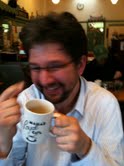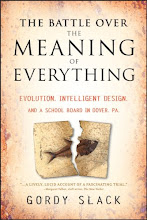On the exhibits floor of the 75th Anniversary American Epilepsy conference in Baltimore this weekend there are many new ways to get inside the heads of epilepsy patients. NeuroPace, for example, is a brain implant that detects the coming of a seizure and responds with electrical stimulation the part of the brain causing the trouble. It's a remarkable device...and it was predicted with amazingly high fidelity by Michael Chrichton as far back as 1971 in his novel (later turned into a movie) Terminal Man. The clinical trial in Chrichton's story don't turn out so well, but its just a novel. Still, let's hope we really know what we're doing as we start installing computers inside of people's heads. There are high hopes, I should say, for NeuroPace. I share them.
Meanwhile, two floors above, in the ballroom of the Baltimore Conference Center neurologist Steven Schachter gave the Judith Hoyer Lecture on Epilepsy. Schachter does some work on high-tech translational medicine at Harvard, where he is a professor of neurology. But he also started the journal Epilepsy and Behavior, was the president of the American Epilepsy Society, and achieved about a half a dozen other things that would put an ordinary epileptologist on the map. Schachter is also the most humane neurologist I've met. He is dedicated to stopping his patients' seizures, yes, but also to helping them wrestle with the other demons that often accompany epilepsy: stigma, employment limitations, loneliness, alienation, depression. He also collects artwork made by people with epilepsy, which he uses both to gain insight into their experience and even to help guide diagnoses and treatment. In a conference that's understandably focused on epileptic brains, Schachter's talk was typically focused on people with epilepsy.
Also part of the Judith Hoyer Lecture was a magnificent performance of a composition by Cynthia Folio. Titled When the Spirit Catches You, the piece is a musical portrait of a Folio's daughter's seizures. Permormed by the seven-member Relache Ensemble, the piece was moody, caucophenous, dreamy, and melancholy. It ends with a child's music box winding down sadly, but sweetly. It is a moving and engaging piece and I hope it is performed again and again. (A four-minute excerpt of the half-hour-long piece is here.)
Shachter's good talk and Folio's performance were recorded and reportedly will be posted on YouTube, so keep a sharp eye out for them.
For more on the AES's annual meeting in Baltimore, follow Lisa Boyland's good blog on the Epilepsy Foundation site.
Subscribe to:
Post Comments (Atom)



4 comments:
So nice content! I find this post a very educational and helpful for all of us who don't have much knowledge about epilepsy. Through this post we're getting more understanding with their condition. Thanks! linden method
Wow! So great content! I love reading this article. Its very helpful and informative. Keep posting! Xtreme NO
OMG, What an awesome article. Extremely helpful :) Thank you for posting this. Phen375 reviews
So folks, any news in here??
Mikes, taoofbadass.
Post a Comment